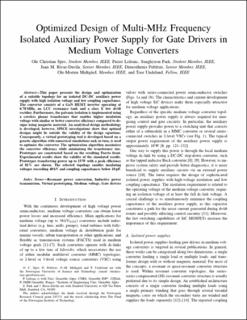| dc.contributor.author | Spro, Ole Christian | |
| dc.contributor.author | Lefranc, Pierre | |
| dc.contributor.author | Par, Sanghyeon | |
| dc.contributor.author | Rivas-Davila, Juan | |
| dc.contributor.author | Peftitsis, Dimosthenis | |
| dc.contributor.author | Midtgård, Ole-Morten | |
| dc.contributor.author | Undeland, Tore Marvin | |
| dc.date.accessioned | 2021-02-08T20:03:27Z | |
| dc.date.available | 2021-02-08T20:03:27Z | |
| dc.date.created | 2020-09-13T14:04:56Z | |
| dc.date.issued | 2020 | |
| dc.identifier.citation | IEEE transactions on power electronics. 2020, 35 (9), 9494-9509. | en_US |
| dc.identifier.issn | 0885-8993 | |
| dc.identifier.uri | https://hdl.handle.net/11250/2726710 | |
| dc.description.abstract | This article presents the design and optimization of a suitable topology for an isolated dc–dc auxiliary power supply with high isolation voltage and low coupling capacitance. The converter consists of a GaN HEMT inverter operating at 6.78 MHz, an LCC resonance tank, and a class-E low dv/dt rectifier. Furthermore, the galvanic isolation is implemented using a coreless planar trans-former that enables higher insulation voltage with similar or better converter efficiency compared to designs using a magnetic material.An analytical design methodology is developed, however, SPICE investigations show that optimal designs might lie outside the validity of the design equations. Consequently, a virtual prototyping tool is developed based on a genetic algorithm with numerical simulations, and in turn, is used to optimize the converter. The optimization algorithm maximizes the converter efficiency while minimizing the transformer size. Prototypes are constructed based on the resulting Pareto front. Experimental results show the validity of the simulated results. Prototypes transferring power up to 15 W with a peak efficiency of 81% are shown. The selected topology enables insulating voltages exceeding 40 kV and coupling capacitances below 10 pF. | en_US |
| dc.language.iso | eng | en_US |
| dc.publisher | IEEE | en_US |
| dc.title | Optimized Design of Multi-MHz Frequency Isolated Auxiliary Power Supply for Gate Drivers in Medium-Voltage Converters | en_US |
| dc.type | Peer reviewed | en_US |
| dc.type | Journal article | en_US |
| dc.description.version | acceptedVersion | en_US |
| dc.source.pagenumber | 9494-9509 | en_US |
| dc.source.volume | 35 | en_US |
| dc.source.journal | IEEE transactions on power electronics | en_US |
| dc.source.issue | 9 | en_US |
| dc.identifier.doi | 10.1109/TPEL.2020.2972977 | |
| dc.identifier.cristin | 1829422 | |
| dc.relation.project | Norges forskningsråd: 243711 | en_US |
| dc.description.localcode | © 2020 IEEE. Personal use of this material is permitted. Permission from IEEE must be obtained for all other uses, in any current or future media, including reprinting/republishing this material for advertising or promotional purposes, creating new collective works, for resale or redistribution to servers or lists, or reuse of any copyrighted component of this work in other works. | en_US |
| cristin.ispublished | true | |
| cristin.fulltext | original | |
| cristin.fulltext | postprint | |
| cristin.qualitycode | 2 | |
